
Vol. 6, No.11, November 2010 |
 Printer-Friendly PDF Version Printer-Friendly PDF Version |
Contents |
The Bushnell Incident
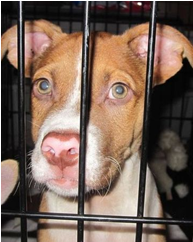
On August 30, 2010, 221 homeless dogs ranging in age from 4 weeks to greater than 1 year arrived by cargo plane from Puerto Rico to Orlando FL. These dogs were destined for transport to New York for a national adoption event over the Labor Day weekend. The plan included a 4-day layover in Bushnell under the care of the Sumter County DART prior to vehicle transport to New York by this transport team.
Unfortunately, several of the imported dogs were incubating parvovirus and distemper virus resulting in exposure of all dogs to both of these deadly pathogens, including the largest group consisting of young pups most susceptible to infection. The State Veterinarian declared an official quarantine due to diseased dogs, representing the first state-mandated quarantine for dogs.


The Incident Command System was instituted for management of this large-scale disease outbreak response, utilizing expertise from Maddie’s Shelter Medicine Program veterinarians, ASPCA disaster response teams and Sumter County and Bay Area DART volunteers. The Florida Veterinary Medical Association assisted in recruitment of volunteer veterinarians, veterinary technicians, veterinary students and veterinary technician students. In addition to equipment and supplies from the Sumter County and Bay Area DART groups, John Haven and UF VETS provided trailers and air-conditioned tents for segregated housing of dogs based on infection status. In all, nearly 200 volunteers responded to this disease management incident, representing at least five different disaster response resources. The disease outbreak intervention strategy resulted in 113 lives saved (51 percent), an amazing feat considering the susceptibility of most of the pups to infection and the hardships associated with limiting viral transmission in a mass sheltering situation.

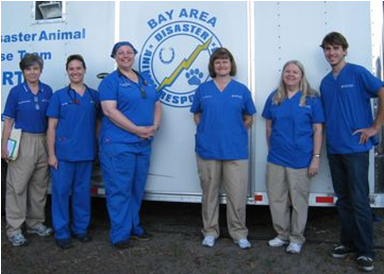
Nearly all of the 113 dogs have been adopted. Of the 108 dogs that died, about 45 percent succumbed to parvoviral disease and 55 percent to distemper virus.
Here are a few important points, at least in my opinion:
1) this is the first time that the State Veterinarian has mandated an official quarantine for a disease outbreak in dogs in Florida (as opposed to the EHV outbreak in horses a few years back);
2) there were a large number of volunteers from various disaster response agencies participating in managing this outbreak, despite the fact that it was not an officially a declared state disaster;
3) the Incident Command System was utilized to manage the number of volunteers necessary for the scope of this incident; and
4) it would have been easy and likely justifiable to euthanize all 221 dogs, but the intervention strategy employed resulted in the saving of 113 dogs’ lives, most of which are now beloved pets in homes. Importantly, the state veterinarians were very supportive of the strategy to save as many lives as possible.

I refer to Sumter County DART as the “transport team” because animal transport is their specialty for emergency/disaster responses, whether transporting animals from shelters to safety in advance of an approaching hurricane or transporting dogs from a puppy mill bust to a receiving facility. This DART group has many types of transport vehicles for these purposes as well as trained and certified drivers.
In contrast, Bay Area DART’s specialty during a disaster/emergency response is sheltering. They are trained to set up and operate temporary mass shelters for animals displaced by any type of disaster.
So, we were fortunate during the Bushnell incident to have these 2 DART groups, each providing their own expertise. Sumter County DART transported 113 medically cleared dogs from the quarantine site to different adoption facilities around the state.
Cynda Crawford, DVM, PhD
Maddie’s Shelter Medicine Program and UF VETS
University of Florida College of Veterinary Medicine


[top]
Building a Better Team
Register now for 2011 Florida SART Planning Meeting
It’s open now. We’re talking registration for the 2011 SART Planning Meeting from February 28 – March 2, 2011 at the Altamonte Springs –Orlando North Hilton.
- Room rates just $93/per night.
- No event fee for registered participants, but go to www.flsart.org to register and book your room (www.flsart.org/hotel). This needs to be done right away and in no case later than January 28 to be eligible for SART’s group rate.
- There’s a light fare reception the evening of February 28 and due to the generosity of several sponsors, complimentary breakfasts will be served on March 1 and 2. On March 1 during the SART awards ceremony, lunch is also complimentary.
"Remember when" moments - SART Conferences Past | |||
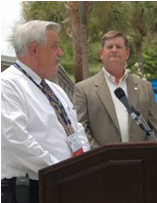 | 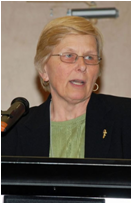 |  | 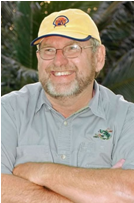 |
Tim Manning and Charles Bronson UF's Joan Dusky UF's Jiannong Xin Joe Kight, ESF-17 | |||
Agenda
The Many Faces of SART | |
 |  |
Liz Wang Serca David Perry | |
 |  |
John Haven Greg Christy | |
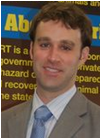 |  |
Michael Turner Art Johnstone | |
Monday February 28 (1:00-5:00 pm)
- 1:00pm
- Welcome: Dr. Tom Holt and Seminole County
- USDA APHIS/Animal Care
- NASAAEP
- Division of Emergency Management Director Mr. Dave Halstead
- FACA President
- County Panel - Issues and Concerns
- (Palm Beach, Sarasota, Orlando, Monroe and Franklin)
- Close SART Chair
- 5:30 - 7:30 Mixer
Tuesday March 01 (8:00 am - 5:00 pm)
-
8:00 - 11:30
- Problem-solving Working Groups
- GROUP 1- Search and Rescue
- GROUP 2- Training Needs
- GROUP 3 - Transportation and Sheltering
-
Noon Awards luncheon - Speaker TBA
-
Afternoon - Field training
- A. Large Animal Technical Rescue
- B. Animal Emergency Care
- C. MARE UNIT and Pet sheltering
Wednesday March 2 (8:00 - noon)
- 8:00 - Noon
- Canine Disease, a case study
- MOU between FVMA & FDOACS
- Florida SARC Report
- Florida veterinary stockpile plan
- Group Reports
- Responses
- Wrap-up and closing remarks
Questions? Check with Michael Turner (850) 410-6761 (turnerm@doacs.state.fl.us) or Joe Kight (kightj@doacs.state.fl.us).
A Florida green hotel and conference center, the Hilton Orlando/Altamonte Springs has a web site at http://www1.hilton.com/en_US/hi/hotel/ALTAHHF-Hilton-Orlando-Altamonte-Springs-Florida/index.do.
[top]
Final 2010 AWR-154 Principles of NIMS Classes
It’s your last chance to take AWR-154 Principles of National Incident Management System, Team Building, and Risk Communication in 2010. Just two classes left, but they are of course free and lunch is provided. Classes normally run from 8:00 am to 4:00 pm.
AWR-154
Principles of National Incident Management System, Team Building, and Risk Communication
Tuesday, November 30
Fort Myers
Regional Operations Center, 4700 Terminal Dr., Suite 6 33901
Wednesday, December 1
Sarasota
County Government, EOC, 1660 Ringling Blvd, 6th Floor 34236
FDACS’ Office of Agricultural Emergency Preparedness partners with the Western Institute of Food Safety and Security to present these DHS Certified Agroterrorism Courses. Additional sponsoring partners include the Institute for Food and Agricultural Sciences (IFAS-Extension), the Dept. of Health and the Regional Domestic Security Task Forces.
To register for a course or for more information go to the WIFSS website at:
Registration:
http://wifss.ucdavis.edu/agroterrorism/classes/classesbydate.php
Course Information:
http://wifss.ucdavis.edu/agroterrorism/classes/course_desc.php
Contact John Terry (850-410-6756 or terryj1@doacs.state.fl.us ) with questions.
NOTE: A superb source of information about diverse training classes – from bed bug infestations to master gardener training – is the UF/IFAS web site at http://calendar.ifas.ufl.edu/calendar/.
[top]
Animal Disease Response & Preparedness Course
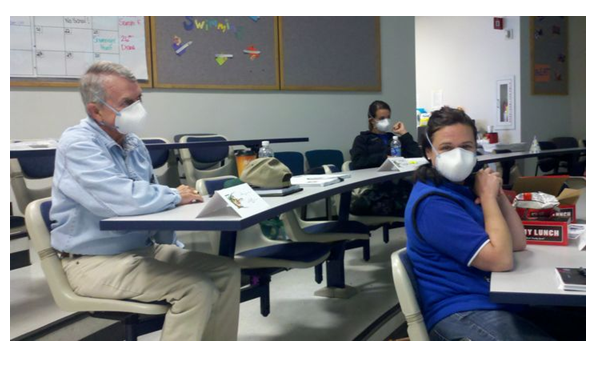
Attendees at UF’s recent Animal Disease Course: [foreground] Dr. William Shelton (Vet Corps) and Dr. Cate McManus (UF – Maddie’s Shelter Medicine Program).
Photo by John Haven who noted that the one-day awareness-level course was offered twice – Tallahassee and Gainesville – with about 70 total professionals in attendance: veterinary students, faculty and staff, DART members, county responders….
“It’s great having experienced people attend,” Haven says, “as they add so much by way of practical knowledge. And having faculty, staff and students sit in a course to learn together is really priceless.”
FDACS’ Dr. Greg Christy says the response to animal emergencies and disease situations can be so complex that it is almost imperative these days that agency partners become cross-trained: “Effective response takes a partnership attitude and opportunities to practice.”
Speaking of Maddie’s Shelter Medicine Program at UF’s College of Veterinary Medicine, here’s a quick overview from www.ufsheltermedicine.com:
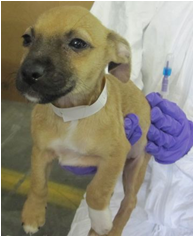 Photo Dr. Cynda Crawford
Photo Dr. Cynda Crawford
Mission:Enhance health/welfare of homeless animals through education, innovation, and advancement of the life-saving goals of sheltering programs
Vision: A comfortable and enriched life for all companion animals
Core Strategies:
- Shelter assessment and consultation
- Training shelter medical professionals to fill the current shortage
- Training veterinary students in the problems of homeless animals, animal sheltering systems, shelter medicine and career opportunities
- Develop knowledge to solve threats to sheltering programs
[top]
An All Too Familiar Story?
|
Budget cuts mean fewer workers at Lake County Animal Control. Earlier this week, the county laid off dozens of people. Now, county leaders want volunteers to help cover the lost jobs in animal control, but that may be difficult. |
but they have never had any success getting them or keeping them. |
|
Reprinted from wftv.com and FACA Trax, official publication of the Florida Animal Control Association at http://floridaanimalcontrol.org/facatrax . | ||
NOTE: To read about the April 2010 grant of $50,000 from Orange County to Harbor House of Central Florida (www.harborhousefl.com) to help build a kennel for pets of domestic violence victims, check out FACA Trax [3rd quarter 2010 http://floridaanimalcontrol.org/facatrax]. The on-site kennel at Harbor House will house up to 20 pets of shelter residents, one of only 37 known nationwide in the American Humane PAWS (Pets and Women’s Shelter) Program.
[top]
FDACS' Gary Painter Celebrates Retirement
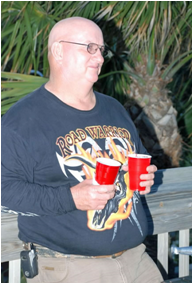
To all the work colleagues and good friends that I’ve met over the past 40+ years within and outside of the Florida Department of Agriculture and Consumer Services. I’d like to say it’s been one “amazing” career.
I joined the Department’s work force on September 1, 1970, after a tour in Vietnam in the Marine Corps. I started as a Livestock Inspector for 7 years and then became a Livestock Inspector Supervisor for 23+ years. Then I moved into a position known as a Sanitation and Safety Specialist to the present. In this position I have worn several different hats, such as working with Oral Rabies Vaccine Program, Division of Animal Industry’s inventory program and was assigned to work in the Emergency Management Task Force Program. Throughout my career in the Department I’ve met some great people and then not so great, but just “different” in their own right, which is what makes the world go around.
In saying this, it’s now time for me to move aside and let a new generation in with new and better ideas for the Department of Agriculture and say “Good luck” to them.
I also wanted to take the time to say “Thanks” to each and every one who has passed through my life during my career of 40+ years within and outside the agriculture industry. They made it all worth it. I was very lucky to become an employee for the Department of Agriculture and Consumer Services and especially with the Division of Animal Industry. I don’t believe I could have stayed that many years if I didn’t love what I was doing and the people as well.
I wish each and every one of you that I have met along the way only the best in your careers.
In Kenny Chesney’s song “Don’t Blink” is the truest statement ever! I’m not a “Good-Bye” person, so I’ll just say “Until we meet again!” So God Bless and Semper Fi all of you!
Gary Painter
[top]
SART News & Notes
The SART Calendar
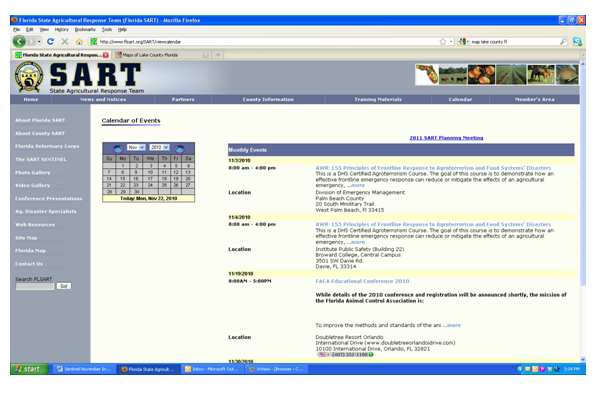
Are you and your organization using the SART Calendar? You can locate this
resource on the SART web site at www.flsart.org/SART/viewcalendar. It lists many of the opportunities for agricultural and animal response training and education for the foreseeable future, each entry answering the 5 Basics: Who, What, Where, When and Why. If you don’t already make use of this free resource, it’s easy to check out what’s coming up. You might just find an opportunity to get involved with something new or learn a new skill or get to know some of the responders you will work with during an emergency.
Bedbugs – Yow!
Bedbugs! It’s reminiscent of the scene from the 1984 movie “Ghostbusters:”
Dr. Peter Venkman: This city is headed for a disaster of biblical proportions.
Mayor: What do you mean, "biblical?"
Dr Ray Stantz: What he means is Old Testament, Mr. Mayor, real wrath of God type stuff.
Dr. Peter Venkman: Exactly.
Dr Ray Stantz: Fire and brimstone coming down from the skies! Rivers and seas boiling!
Dr. Egon Spengler: Forty years of darkness! Earthquakes, volcanoes...
Winston Zeddemore: The dead rising from the grave!
Dr. Peter Venkman: Human sacrifice, dogs and cats living together... mass hysteria!
Mayor: All right, all right! I get the point!
 Ghostbusters battle bedbugs in the Xbox 360 computer game.
Ghostbusters battle bedbugs in the Xbox 360 computer game.
They forgot the bedbugs. If you have or think you have bedbugs, FDACS says call a licensed pest control company because getting rid of them yourself is not easy and pesticides can be dangerous.
The size of an apple seed, bedbugs have made a comeback as many of the pesticides of the past can no longer be used. Staying at a hotel, going to the movies, riding in a taxi or spending time in other places where people congregate can spread the bugs.
Like many states, Florida has recently had an increase in the number of bedbug complaints. The creatures come out at night, are hard to detect and can often remain unnoticed while breeding. FDACS says using bedbug monitors and traps is an easy, relatively inexpensive way to find infestations that can help target treatments http://bedbugger.com/forum/topic/homemade-bed-barriers-climbup-interceptors.
Peach Fruit Fly
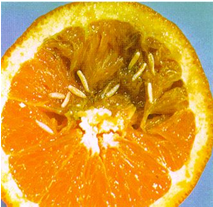 Fruit fly infestation in orange.
Fruit fly infestation in orange.
The Bad News: A USDA inspector recently found a peach fruit fly, Bactrocera zonata, in a trap in a guava tree in Miami-Dade County, the first Florida find for this species. The Good News: The fruit fly detection program works.
Afterwards, the trapping program intensified in an 81-square-mile area surrounding the fruit fly find. If any more flies are found an insecticide might be applied to telephone poles along with a substance that attracts flies. The public will be notified 24 hours prior to the application. (www.fl-dpi.com/enpp/ento/exoticfruitflies.html 888-397-1517)
[top]
About the SART Sentinel |
The SART SENTINEL is an E-mail newsletter prepared monthly by the members of the Florida State Agricultural Response Team. Past issues of the Sentinel are archived on the Florida SART Web Site, www.flsart.org. If you have a story or photo that you would like to have considered for publication in The SART SENTINEL, please contact the Editors. Editor: Rick Sapp, PhD, Technical Writer, Florida Department of Agriculture & Consumer Services, Division of Animal Industry [rsa5@cox.net] Associate Editor: Joe Kight, State ESF-17 Coordinator, Florida Department of Agriculture & Consumer Services, Division of Animal Industry [kightj@doacs.state.fl.us] [top] |
